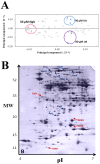Escherichia coli response to uranyl exposure at low pH and associated protein regulations
- PMID: 24587082
- PMCID: PMC3935937
- DOI: 10.1371/journal.pone.0089863
Escherichia coli response to uranyl exposure at low pH and associated protein regulations
Abstract
Better understanding of uranyl toxicity in bacteria is necessary to optimize strains for bioremediation purposes or for using bacteria as biodetectors for bioavailable uranyl. In this study, after different steps of optimization, Escherichia coli cells were exposed to uranyl at low pH to minimize uranyl precipitation and to increase its bioavailability. Bacteria were adapted to mid acidic pH before exposure to 50 or 80 µM uranyl acetate for two hours at pH≈3. To evaluate the impact of uranium, growth in these conditions were compared and the same rates of cells survival were observed in control and uranyl exposed cultures. Additionally, this impact was analyzed by two-dimensional differential gel electrophoresis proteomics to discover protein actors specifically present or accumulated in contact with uranium.Exposure to uranium resulted in differential accumulation of proteins associated with oxidative stress and in the accumulation of the NADH/quinone oxidoreductase WrbA. This FMN dependent protein performs obligate two-electron reduction of quinones, and may be involved in cells response to oxidative stress. Interestingly, this WrbA protein presents similarities with the chromate reductase from E. coli, which was shown to reduce uranyl in vitro.
Conflict of interest statement
Figures




Similar articles
-
Nephrotoxicity of uranyl acetate: effect on rat kidney brush border membrane vesicles.Arch Toxicol. 2006 Jul;80(7):387-93. doi: 10.1007/s00204-006-0064-6. Epub 2006 Feb 16. Arch Toxicol. 2006. PMID: 16482472
-
Interaction of Uranium with Bacterial Cell Surfaces: Inferences from Phosphatase-Mediated Uranium Precipitation.Appl Environ Microbiol. 2016 Jul 29;82(16):4965-74. doi: 10.1128/AEM.00728-16. Print 2016 Aug 15. Appl Environ Microbiol. 2016. PMID: 27287317 Free PMC article.
-
Uranyl acetate causes DNA single strand breaks in vitro in the presence of ascorbate (vitamin C).Chem Res Toxicol. 2003 Apr;16(4):524-30. doi: 10.1021/tx025685q. Chem Res Toxicol. 2003. PMID: 12703969
-
Recent advances in uranyl binding in proteins thanks to biomimetic peptides.J Inorg Biochem. 2020 Feb;203:110936. doi: 10.1016/j.jinorgbio.2019.110936. Epub 2019 Nov 19. J Inorg Biochem. 2020. PMID: 31864150 Review.
-
Current two-dimensional electrophoresis technology for proteomics.Proteomics. 2004 Dec;4(12):3665-85. doi: 10.1002/pmic.200401031. Proteomics. 2004. PMID: 15543535 Review.
Cited by
-
Transcriptome Response of the Tropical Marine Yeast Yarrowia lipolytica on Exposure to Uranium.Curr Microbiol. 2021 May;78(5):2033-2043. doi: 10.1007/s00284-021-02459-z. Epub 2021 Mar 27. Curr Microbiol. 2021. PMID: 33772621
-
Mechanisms of Chromium and Uranium Toxicity in Pseudomonas stutzeri RCH2 Grown under Anaerobic Nitrate-Reducing Conditions.Front Microbiol. 2017 Aug 10;8:1529. doi: 10.3389/fmicb.2017.01529. eCollection 2017. Front Microbiol. 2017. PMID: 28848534 Free PMC article.
-
Naturalized Escherichia coli in Wastewater and the Co-evolution of Bacterial Resistance to Water Treatment and Antibiotics.Front Microbiol. 2022 May 30;13:810312. doi: 10.3389/fmicb.2022.810312. eCollection 2022. Front Microbiol. 2022. PMID: 35707173 Free PMC article. Review.
-
Discovery and characterization of UipA, a uranium- and iron-binding PepSY protein involved in uranium tolerance by soil bacteria.ISME J. 2022 Mar;16(3):705-716. doi: 10.1038/s41396-021-01113-7. Epub 2021 Sep 23. ISME J. 2022. PMID: 34556817 Free PMC article.
-
Modulation of medium pH by Caulobacter crescentus facilitates recovery from uranium-induced growth arrest.Appl Environ Microbiol. 2014 Sep;80(18):5680-8. doi: 10.1128/AEM.01294-14. Epub 2014 Jul 7. Appl Environ Microbiol. 2014. PMID: 25002429 Free PMC article.
References
-
- Taylor DM, Taylor SK (1997) Environmental uranium and human health. Rev Environ Health 12: 147–157. - PubMed
-
- Brugge D, de Lemos JL, Oldmixon B (2005) Exposure pathways and health effects associated with chemical and radiological toxicity of natural uranium: a review. Rev Environ Health 20: 177–193. - PubMed
-
- Maher K, Bargar JR, Brown GE Jr (2013) Environmental speciation of actinides. Inorg Chem 52: 3510–3532. - PubMed
-
- Li W, Victor D, Chakrabarlti C (1980) Effect of pH and Uranium Concentration on Interaction of Uranium(VI) and Uranium(IV) with organic Ligand in aqueous Solutions. Anal Chem 52: 520–523.
Publication types
MeSH terms
Substances
LinkOut - more resources
Full Text Sources
Other Literature Sources
Molecular Biology Databases

